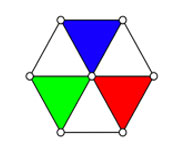


 تاريخ الرياضيات
تاريخ الرياضيات
 الرياضيات في الحضارات المختلفة
الرياضيات في الحضارات المختلفة 
 الرياضيات المتقطعة
الرياضيات المتقطعة
 الجبر
الجبر
 الهندسة
الهندسة 
 المعادلات التفاضلية و التكاملية
المعادلات التفاضلية و التكاملية 
 التحليل
التحليل
 علماء الرياضيات
علماء الرياضيات |
Read More
Date: 23-4-2022
Date: 11-5-2022
Date: 28-2-2022
|
Zarankiewicz's conjecture asserts that graph crossing number for a complete bipartite graph 
 |
(1) |
where 
The problem addressed by the conjecture is sometimes known as the brick factory problem, since it was described by Turán (1977) as follows: "We worked near Budapest, in a brick factory. There were some kilns where the bricks were made and some open storage yards where the bricks were stored. All the kilns were connected to all the storage yards. The bricks were carried on small wheeled trucks to the storage yards. All we had to do was to put the bricks on the trucks at the kilns, push the trucks to the storage yards, and unload them there. We had a reasonable piece rate for the trucks, and the work itself was not difficult; the trouble was at the crossings. The trucks generally jumped the rails there, and the bricks fell out from them, in short this caused a lot of trouble and loss of time which was precious to all of us. We were all sweating and cursing at such occasions, I too; but nolens volens the idea occurred to me that this loss of time could have been minimized if the number of crossings of the rails had been minimized. But what is the minimum number of crossings? I realized after several days that the actual situation could have been improved, but the exact solution of the general problem with m kilns and n storage yards seemed to be very difficult. The problem occurred to me again at my first visit to Poland where I met Zarankiewicz."
The conjecture has been shown to be true for all 



| 1 | 2 | 3 | 4 | 5 | 6 | 7 | |
| 1 | 0 | 0 | 0 | 0 | 0 | 0 | 0 |
| 2 | 0 | 0 | 0 | 0 | 0 | 0 | |
| 3 | 1 | 2 | 4 | 6 | 9 | ||
| 4 | 4 | 8 | 12 | 18 | |||
| 5 | 16 | 24 | 36 | ||||
| 6 | 36 | 54 | |||||
| 7 | 81 |
Richter and Širáň (1996) computed the crossing number of the complete bipartite graph 
 |
(2) |
Kleitman (1970, 1976) showed that the crossing numbers for 



 |
(3) |
giving the specific equations
 |
 |
 |
(4) |
 |
 |
 |
(5) |
 |
 |
 |
(6) |
 |
 |
 |
(7) |
for all positive 
de Klerk, E.; Maharry, J.; Pasechnik, D. V.; Richter, R. B.; Salazar, G. "Improved Bounds for the Crossing Numbers of 

https://arxiv.org/pdf/math/0404142.pdf.Guy, R. K. "The Decline and Fall of Zarankiewicz's Theorem." In Proof Techniques in Graph Theory, Proceedings of the Second Ann Arbor Graph Theory Conference, Ann Arbor, Michigan, 1968. New York: Academic Press, pp. 63-69, 1969.
Kővari, T.; Sós, V. T.; and Turán, P. "On a Problem of K. Zarankiewicz." Colloq. Math. 3, 50-57, 1954.
Kleitman, D. J. "The Crossing Number of 
Richter, R. B. and Širáň, J. "The Crossing Number of 
Richter, R. B. and Thomassen, C. "Relations Between Crossing Numbers of Complete and Complete Bipartite Graphs." Amer. Math. Monthly 104, 131-137, 1997.
Turán, P. "A Note of Welcome." J. Graph Th. 1, 7-9, 1977.Woodall, D. R. "Cyclic-Order Graphs and Zarankiewicz's Crossing-Number Conjecture." J. Graph Th. 16, 657-691, 1993.
Zarankiewicz, K. "On a Problem of P. Turán Concerning Graphs." Fund. Math. 41, 137-145, 1954.



|
|
|
|
لصحة القلب والأمعاء.. 8 أطعمة لا غنى عنها
|
|
|
|
|
|
|
حل سحري لخلايا البيروفسكايت الشمسية.. يرفع كفاءتها إلى 26%
|
|
|
|
|
|
|
مستشفى الكفيل: ورشة التعليم الطبّي تعمل على توعية الملاكات التدريسية بطرائق الامتحانات العملية الحديثة
|
|
|